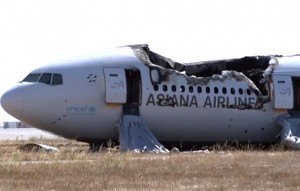Airspeed is Life
Questions about the Asiana 214 crash start with: How did experienced pilots let a plane get so low and slow on a visual approach?
The recent crash of an Asiana Boeing 777 at San Francisco International Airport is a perplexing case. How does a jetliner as sophisticated as a 777 crash on a routine visual approach, in good weather, with no mechanical problems?
Like most pilots, I am very hesitant to speculate on accidents like this until the facts are in. So many factors can contribute to an accident, but in this case it’s hard not to think those dreaded two words: pilot error. How do experienced pilots let a plane get so low and slow on a visual approach? Was something distracting them? The cockpit voice recorder might shed some light on this, and I’m anxiously awaiting the findings of the NTSB, though experience says that wait could be a year or more.
If you’ve read much about this accident, you know that the pilot in the left seat was new to the 777, although he was a Captain with Asiana who had logged around 10,000 hours in various aircraft. The right seat pilot was an instructor pilot who was technically the pilot in command, overseeing the new Captain in the left seat. Some people outside the industry were aghast that a pilot with so few hours in the plane could be flying it. But every pilot has to get his first hours in a new type, and those hours are accumulated during revenue flights (i.e. carrying passengers). When a pilot transitions to a new type, or when he upgrades from First Officer to Captain, he goes through a training program that includes ground school (systems knowledge), simulator training (normal procedures as well as abnormal and emergency situations) and, finally, IOE (Initial Operating Experience), which consists of revenue flights with an instructor pilot/check airman riding along in the other seat. IOE will generally be about 20 hours of flight experience for domestic pilots and somewhat more for international pilots. So…we don’t really have a “beginner” in the left seat, as some news reports have implied.
For this approach, the ILS (Instrument Landing System) for the runway was out of service, and some early news reports implied that this might have been a contributing factor. It’s true that having an electronic glideslope is helpful, but any experienced pilot can make an approach with nothing more than visual cues, using the simple 3-to-1 rule as a good crosscheck (for every mile from the runway, we should be about 300 feet above the ground, so we should be at 1,500 feet when on a five-mile final). In fact, there are many runways at major airports that don’t even have an electronic glideslope. Runway 19 at Washington National and Runway 31 at New York’s La Guardia airport are two that come to mind.
Also, in this case there was a visual aid for flying a proper glideslope. Runway 28L at SFO has a PAPI, Precision Approach Path Indicator, to the left of the runway. The PAPI is a set of four lights, each split between a lower red light and an upper white light. Depending on the plane’s descent angle, the light will appear red when low or white when high. Each of the four lights has a slightly different angle for where the transition between red and white occurs. If you are on the proper glidepath, you’ll see two white and two red lights (a 2.85° glidepath for this runway). If you see four red lights, you’re much too low; four white lights and you’re much too high.
The focus now seems to be on the crew’s over-reliance on automation, perhaps coupled with some misunderstanding of the various modes of the automation. This is somewhat reminiscent of the Air France crash over the Atlantic in June 2009; in both cases airmanship has come into question. Automation (autopilot, autothrottles and a computer loaded with speed and altitude restrictions) can be a great tool on a plane, but in some cases, particularly when lots of quick changes are required in a short time (as on final approach with Air Traffic Control throwing altitude and speed restrictions at you), it can be preferable to turn off the autopilot and just hand-fly the plane.
For me, the most amazing thing about this accident is how a crew could get that slow on an approach. I wasn’t there, so I don’t know what distractions there might have been. But I can’t remember the last time I’ve seen a fellow pilot get as much as 10 knots slow on an approach, never mind the 30+ knots under speed for Asiana 214. If the flying pilot gets even five knots slow, the other pilot will call out “airspeed” and expect a reply of “correcting,” along with necessary power and/or pitch inputs to regain the speed. Airspeed is life, and every pilot knows it.
/https://tf-cmsv2-smithsonianmag-media.s3.amazonaws.com/accounts/headshot/Steve-Satre-headshot.jpg)


/https://tf-cmsv2-smithsonianmag-media.s3.amazonaws.com/accounts/headshot/Steve-Satre-headshot.jpg)